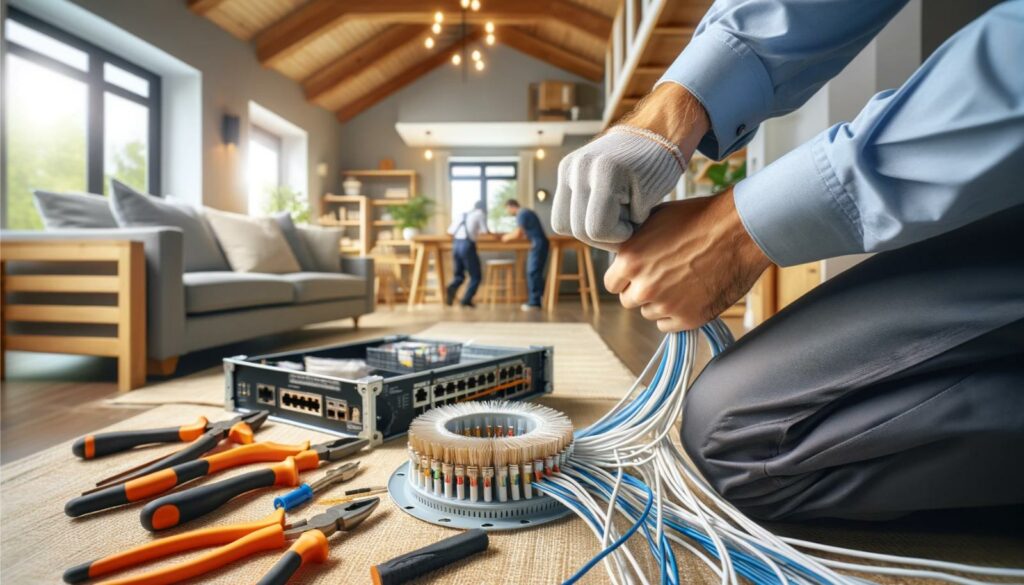Moving into a new house is an exciting journey, but it also comes with its set of challenges, one of which is setting up a reliable internet connection. In today’s digital age, having fast and stable internet is as essential as utilities like water and electricity. In this guide, we’ll walk you through each step of getting your internet up and running in your new home.
Determining Your Internet Needs
First things first, it’s important to assess your internet usage and understand your specific needs. Take a moment to consider your online activities and how you utilize the internet on a daily basis. Are you a passionate streaming enthusiast, spending hours indulging in your favorite movies and TV shows? Or perhaps you’re an avid online gamer, immersing yourself in thrilling virtual worlds and engaging multiplayer experiences. Alternatively, maybe you’re someone who relies heavily on a stable internet connection for work, with tasks like video conferences, large file transfers, and remote collaboration becoming the norm.
Understanding your internet needs is crucial because they will vary depending on the nature of your online activities. For instance, activities such as streaming content in high-definition or even 4K resolution, as well as online gaming, require higher bandwidth and faster speeds to ensure smooth and uninterrupted experiences. On the other hand, if your internet usage mainly revolves around basic browsing, emailing, and occasional video calls, you may not require as much bandwidth.
By assessing your internet needs accurately, you can make informed decisions when choosing an internet plan that caters to your specific requirements. This way, you can ensure that you have the right level of service to support your online activities and enjoy a seamless internet experience.

Researching Internet Service Providers (ISPs) in Your Area
When it comes to finding the right Internet Service Provider (ISP) for your new area, conducting thorough research is crucial. To start, consider performing a simple online search or visiting ISP websites to gather information about the available options. Take your time to compare their plans, pricing, and customer reviews, as this will help you make an informed decision.
While comparing ISPs, keep an eye out for package deals that might offer additional benefits or savings. Additionally, take note of any promotional offers that may be available, as they can provide you with added value. Lastly, pay attention to the contract terms of each ISP, as understanding the terms and conditions can help you avoid any surprises down the line.
By taking these additional steps and diving deeper into your research, you can ensure that you choose the right ISP that meets your specific needs and preferences.

Understanding Different Types of Internet Connections
In today’s digital age, it is crucial to have a clear understanding of the various types of internet connections available. Let’s explore the four main types: DSL, Cable, Fiber-optic, and Satellite, each with its own set of advantages and limitations.
DSL (Digital Subscriber Line) is a widely available option that utilizes existing telephone lines to transmit data. While it may not offer the fastest speeds compared to other options, DSL remains a reliable choice for many users.
Cable internet, on the other hand, takes advantage of cable television infrastructure to provide high-speed internet access. With its widespread availability and decent speeds, cable internet has become a popular choice for households and businesses alike.
Fiber-optic internet is the pinnacle of speed and performance, utilizing thin strands of glass or plastic to transmit data at lightning-fast speeds. However, due to the infrastructure required, fiber-optic internet may not be available in all areas yet.
Lastly, satellite internet serves as an alternative for those residing in rural or remote areas where traditional connections may not be feasible. While it offers the convenience of accessibility, satellite internet often comes with higher latency due to the long-distance data transmission.
By understanding the differences and nuances between these internet connection types, individuals can make informed decisions based on their specific needs and location. Stay connected and enjoy the benefits of the digital world!
Checking for Pre-existing Infrastructure
When inspecting your new home, take the time to carefully examine any existing infrastructure such as cable lines or satellite dishes. This can provide valuable insight into what previous owners used for their entertainment needs, potentially saving you both installation costs and time. By being aware of these pre-existing features, you can make more informed decisions about your own setup and ensure a seamless transition into your new home.

Scheduling an Installation
Once you have carefully selected your ISP (Internet Service Provider), it is time to schedule the installation. The installation process can vary, ranging from a straightforward self-install kit to the presence of a professional technician who will visit your location. It is crucial to be present at home during the scheduled time to ensure a smooth setup. Additionally, it is helpful to have a clear idea of the preferred location for the equipment to be set up, ensuring optimal placement for seamless connectivity. Taking these steps will help ensure a hassle-free installation experience.
Setting Up Your Home Network
When it comes to choosing a good wireless router, there are a few key factors to consider. Firstly, it’s crucial to opt for routers that support the latest Wi-Fi standards, such as IEEE 802.11ac or 802.11ax, as they can provide better performance and faster speeds. Additionally, placing your router centrally in your home or office and elevating it can help avoid obstructions and maximize coverage, ensuring a stronger and more reliable Wi-Fi signal throughout your space. By taking these factors into account, you can ensure that you have a well-equipped wireless router that meets your needs and delivers optimal performance.
Securing Your Home Wi-Fi Network
Ensuring the security of your network is of utmost importance. One crucial step is to change the default password of your router, as this prevents unauthorized access. Additionally, enabling WPA3 encryption adds an extra layer of protection, making it harder for intruders to compromise your network. Lastly, it is highly recommended to regularly update your router’s firmware. By doing so, you can benefit from the latest security patches and enhancements, further safeguarding your network against potential threats. Following these comprehensive steps significantly reduces the risk of unauthorized access to your network, providing you with peace of mind and a secure online experience.
Testing and Troubleshooting Your Internet Connection
After completing the installation process, it is advisable to test your internet speed using reliable online speed test tools. These tools provide accurate measurements of your connection speed, allowing you to assess its performance. If the speed test results are lower than expected, you can try some basic troubleshooting techniques. For instance, you can restart your router to refresh the connection or check for any physical obstructions that might be hindering the signal strength. Taking these simple steps can help you optimize your internet speed and ensure a seamless online experience.
Considerations for Smart Home Devices
If you have smart home devices, it’s crucial to ensure that your internet plan is capable of handling multiple devices connected simultaneously. A robust and stable connection is the foundation for a seamless smart home experience, allowing you to effortlessly control and manage your devices with ease. By having a reliable internet connection, you can enjoy the convenience and efficiency of a fully connected smart home ecosystem, where everything works harmoniously together to enhance your daily life.
FAQs
I’m moving to a new house. When should I arrange for internet installation?
Well, you wouldn’t want to be left in the digital dark ages now, would you? We recommend reaching out to your chosen Internet Service Provider (ISP) at least two weeks beforehand. This ensures that by the time you’re deciding where to hang your Warhol replica, you’ll also have seamless internet to stream your favorite housewarming tunes.
How do I determine what internet speed I need?
Ah, the need for speed! It all boils down to what you’re using your internet for. If you’re the kind of person who loves binge-watching movies in 4K, hosts epic online gaming battles, or works from home, you’ll need higher speeds. For simple browsing or checking emails, not so much. Think tortoise and hare: sometimes slow and steady wins the race!
How can I find the best ISP in my area?
The internet is your friend here! A quick online search or a visit to ISP websites will reveal the options in your areCompare plans, prices, and customer reviews. It’s like online dating, but the perfect match is a hassle-free internet connection!
What are the types of internet connections, and how do they differ?
Much like ice cream, internet connections come in different flavors: DSL, Cable, Fiber-optic, and Satellite. Each has its strengths and weaknesses. Fiber-optic is like the Ferrari of internet connections – super fast but not available everywhere. DSL is more like a reliable old sedan: slower, but gets you where you need to go.
How do I check for pre-existing infrastructure?
Put your detective glasses on and start exploring your new home. Look for cable lines, satellite dishes, or other telltale signs. Who knows? Maybe you’ll stumble upon a vintage collection of vinyl records in the attic while you’re at it!
How do I schedule an installation?
Simply contact your ISP once you’ve chosen a plan that suits your needs and set up an appointment. It’s a bit like setting up a playdate, but instead of kids and building blocks, it’s you and your new router.
What should I consider when setting up a home network?
Choosing a good router is paramount. Go for one that supports the latest Wi-Fi standards. And remember, location is everything! Position your router centrally and elevated to avoid obstructions, like that giant ficus plant you insist on keeping.
How do I ensure my Wi-Fi network is secure?
Remember, your Wi-Fi network is your castle, and you are the king or queen! Change the default router password, enable WPA3 encryption, and keep your router’s firmware updated to fortify your digital fortress.
My internet speed seems slow. What should I do?
No need to panic! Try basic troubleshooting steps like restarting your router or checking for physical obstructions. If you’re still stuck in the slow lane, contact your ISP. They might not be speed wizards, but they can certainly help!
How do I ensure a seamless experience with my smart home devices?
Your internet plan should be able to handle the load of multiple devices connected simultaneously. So, whether you’re commanding Alexa, dimming the lights, or streaming the latest blockbuster, a strong and stable connection ensures your smart home runs as smoothly as a Broadway show.
Conclusion
With these steps, setting up internet in your new house should be a breeze. Remember, a reliable internet connection is the backbone of a modern home, powering everything from entertainment to work to smart home devices. Welcome to your new home, and enjoy your connected lifestyle!

